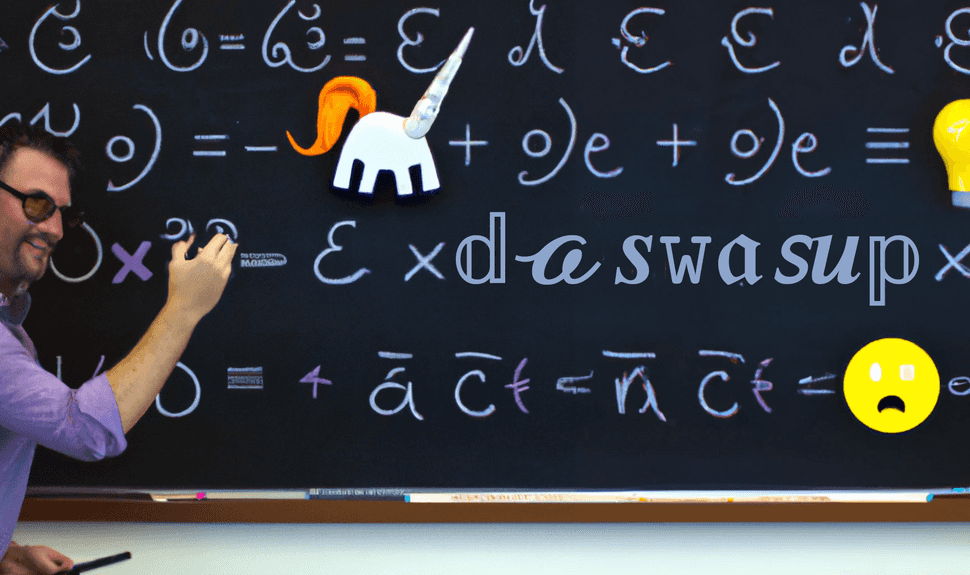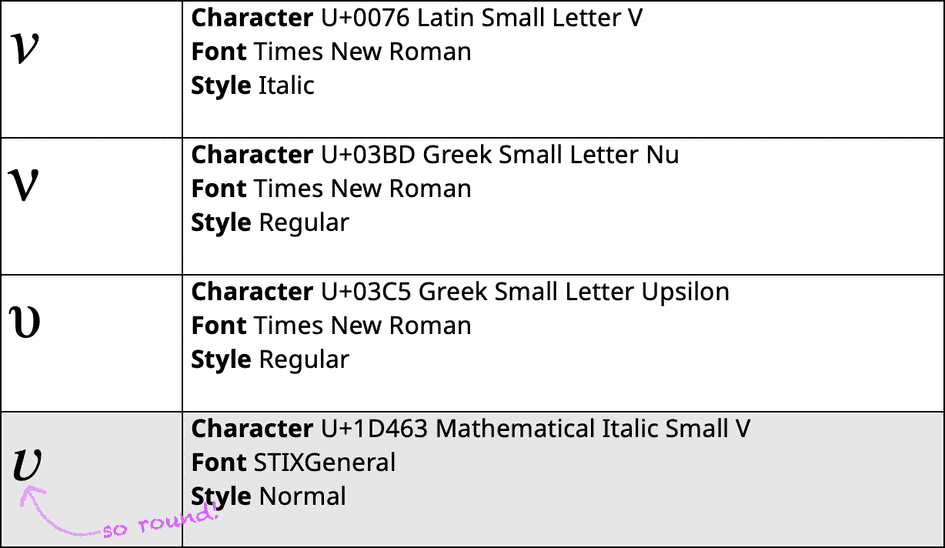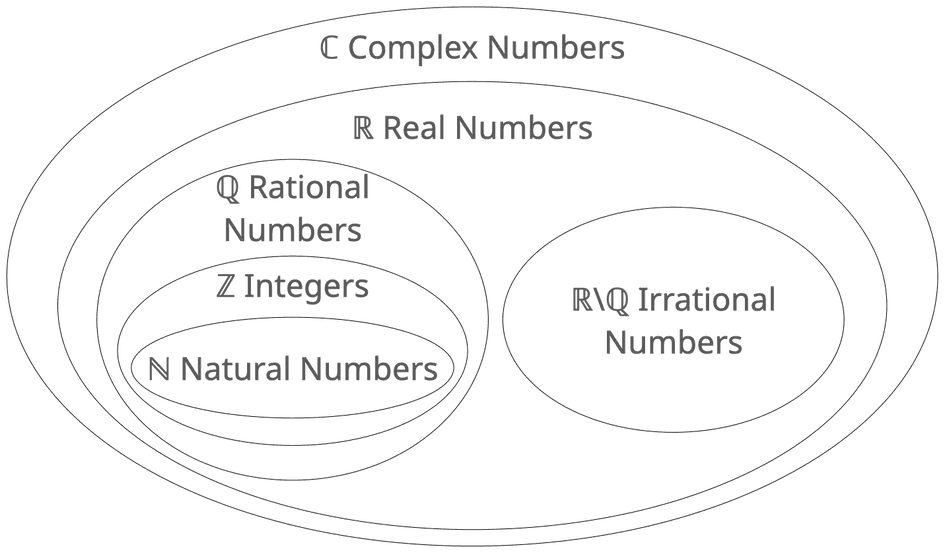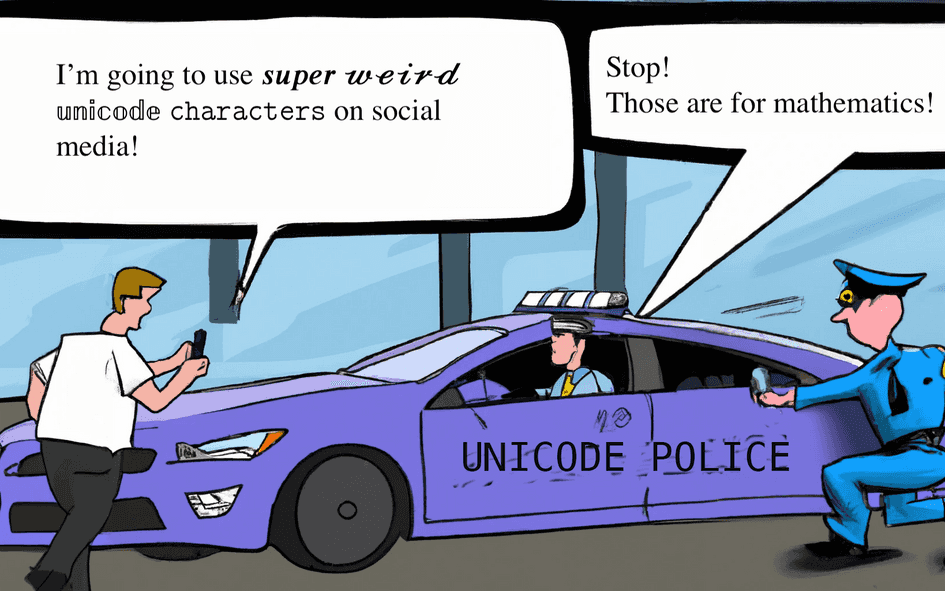
The text characters used to make bold, italic, and cursive text styles (and more!) on YayText were not created to help people make their social media posts stand out, or to make their usernames look cool and unique. Each of the characters in the word 𝐰ℎ𝒊𝗉𝗽𝘦𝙧𝓈𝓷𝔞𝖕𝚙𝕖𝐫 was actually made to be used in mathematical notation. These letters all come from the Mathematical Alphanumeric Symbols Unicode block.
Many of the characters used by YayText's text generators were originally meant for mathematicians, scientists, and engineers. People who work in scientific and technical fields need to represent complex ideas, equations, formulas, and data -- and they have their own Unicode characters to help make this happen.
In mathematics, precise meaning is often communicated through subtle variations in letter style. The two formulas ℋ=∫𝑑𝜏(𝜖𝐸2+𝜇𝐻2) and H=∫dτ(ϵE2+μH2) mean two different things. One is the Hamiltonian formula and the other is the integral equation. Without their specific letter stylings, confusion could arise. In math, science, and engineering this sort of confusion can cause buildings to collapse, rockets to stray off course, and bank accounts to get drained 😱.
According to the Unicode Consortium, characters from the Mathematical Alphanumeric Symbols block should only be used "in mathematical or technical notation, and not in nontechnical text", but if the peach emoji 🍑 can be used for multiple purposes, then why can't the letters in 𝐰ℎ𝒊𝗉𝗽𝘦𝙧𝓈𝓷𝔞𝖕𝚙𝕖𝐫?
[Actually, there are at least two important scenarios where you should avoid using math characters in general text. We discuss these at the end of this article.]
- Bold text to represent vectors
- Bold and bold italic text to represent matrices
- Italics for variables and constants
- Mathematical italics and disambiguation
- Italics for theorems
- Script and cursive-like letters in mathematics
- Character slant and overhangs
- Double-struck characters and mathematical sets
- Fraktur
- Using alphanumeric math symbols for the fun of it
- Compatibility and accessibility
- Bye!
Bold text to represent vectors
Bold text can be used to emphasize a word or capture the reader's attention, but the bold characters used by YayText are hijacked from Unicode's Mathematical Alphanumeric Symbols block. They have a different intended purpose.
In math and physics, bold characters (usually lowercase) are often used to represent vectors. A vector is a way to describe a quantity that has both size (or magnitude) and direction. For example, "speed" (e.g. 50 mph) is not a vector quantity, but "velocity" (e.g. 50 mph, northwest) is.
In the formula for Newton's second law of motion (𝐅 = m𝐚), the letter 𝐅 (force) and letter 𝐚 (acceleration) are vector quantities, and therefore use bold characters. Uppercase 𝐁 is often used to denote a magnetic field and uppercase 𝐄 is often used to denote an electric field. Magnetic and electric fields are also vector quantities.
Bold and bold italic text to represent matrices
Bold uppercase characters (sometimes also italicized) can also be used to represent matrices. A matrix is a table or array of numbers. Matrices can be used to represent shapes, solve equations, and understand how things change or transform. For example 𝐌₃ₓ₂ or 𝑴₃ₓ₂ can be used to indicate a 3 x 2 matrix.
Italics for variables and constants
In written language, italics are often used to emphasize a point or to highlight a specific idea. Italic text can also be used to refer to names of things like movies, books, and songs.
In math, italics are used to denote single-letter variables, physical quantities, and physical constants. For example, the italicized 𝑥 is commonly used to represent an unknown variable in a function or equation. The italicized 𝑡 is often used as a variable representing time, and 𝑛 is often used to represent a term number in a sequence.
The character ℎ is used to represent Planck's constant, 𝑒 is used to represent the elementary charge, and the symbol for the speed of light is 𝑐.
Fun fact (well, depending on your definition of fun)... the ℎ unicode character pre-dates the Mathematical Alphanumeric Symbols block. It was added to the Letterlike Symbols block in Unicode 1.1 (1993) along with 24 other alphanumeric math characters. Most of the other characters had to wait until the Mathematical Alphanumeric Symbols block was added to Unicode 3.1 (2001).
Two-letter variables like Re (the Reynolds number in fluid dynamics) are not italicized, so that text isn't interpreted as two different single-letter variables being multiplied together.
Mathematical italics and disambiguation
Unlike standard writing, mathematical notation can contain Latin and Greek letters side-by-side. Mathematical italic characters differ from the standard italic characters intended for written text. Mathematical italic Latin letters are designed to look distinct from Greek letters, to help avoid confusion.
For example, the non-mathematical italic lowercase v looks almost identical to the Greek lowercase nu. However, the mathematical italic lowercase v is more rounded compared to a regular lowercase v. This helps the reader differentiate it from the lowercase Greek nu and lowercase Greek upsilon.

Italics for theorems
According to the American Mathematical Society Style Guide, the text of theorems should be italicized, as seen in the example below.

Because italics can be used for both variables and theorems, it is important that italicized mathematical variables and italicized mathematical text look visually distinct from each other.
Script and cursive-like letters in mathematics
If you wanted to DM people a fancy wedding invite you could use YayText's cursive text generator to generate the text: 𝒴ℴ𝓊 𝒶𝓇ℯ 𝒸ℴ𝓇𝒹𝒾𝒶𝓁𝓁𝓎 𝒾𝓃𝓋𝒾𝓉ℯ𝒹 𝓉ℴ ℴ𝓊𝓇 𝓌ℯ𝒹𝒹𝒾𝓃ℊ. But, these calligraphic-looking letters are meant for math, and are part of unicode's Mathematical Alphanumeric Symbols block.
These characters are used to represent various mathematical operators, functions, and transforms. Operators manipulate mathematical objects, functions establish relationships between inputs and outputs, and transforms provide alternative insights into mathematical structures or systems.
Here are some notable examples of mathematical concepts represented with letters in the cursive script text style:
ℬ Bernoulli function - [so... actually... your humble author is a little confused. This ℬ character was added to Unicode 1.1 in 1993, before the Mathematical Alphanumeric Symbols block was created, and is described in the standard as "Bernoulli function". Bernoulli's principle, Bernoulli's distribution, and Bernoulli's equation are all real math things -- but none of them use the script uppercase B. Also, what exactly is a Bernoulli function? The ℬ character is used in math, but I can't find a solid evidence of how its related to Bernoulli functions. Anyone have any ideas?]

ℰ Electromotive force - [This is the driving power that makes electric current flow in a circuit. But I'm still a little confused... while the Unicode spec defines the script capital e as the symbol for EMF, it looks like ε (epsilon) and ϵ (lunate epsilon) are more commonly used to represent EMF.)

ℱ Fourier transform - This transform lets you break down a function into its different frequencies and understand signals and patterns.
ℋ Hamiltonian operator - This operator helps to calculate the total energy of a system in physics and understand how it changes over time.
ℒ Laplace transform and Lagrangian function - These are two different things that both use the same character. The Laplace transform is used to convert a function of time into a function of complex frequency. The Lagrangian function is used in in optimization theory.
ℳ M-matrix - This is a special type of matrix used in the study of linear systems, which helps us understand stability and behavior in physics and control theory. [Again, in the Unicode spec, but not sure if physicists really use this symbol. Any physicists reading this?]

℘ Weierstrass elliptic function - This function is mathematical tool used to study elliptic curves and understand intricate geometric patterns. This ℘ character (U+2118) is distinct from uppercase script 𝒫 (U+1D4AB) and lowercase script 𝓅 (U+1D4C5).
ℛ Riemann integral - A method of calculating the area under a curve, helping us solve problems involving accumulation and measurement in calculus. As seen in Rudin's proof.
𝒮 A system's action - In physics, "action" can have multiple meanings, but basically this character represents the overall behavior and changes of a physical system.
Character slant and overhangs
The slant and overhangs (the parts of letters that hang below the baseline) of mathematical script and mathematical italic characters are less pronounced compared to fonts that are designed purely for writing. This is because these characters often need to be modified with diacritic marks (e.g. 𝑎̂), subscript characters (e.g. 𝒷ₓ) and superscripts (e.g. 𝑪ᶻ). If the letters were too decorative, they wouldn't work well in math.
Double-struck characters and mathematical sets
Characters that look 𝕝𝕚𝕜𝕖 𝕥𝕙𝕚𝕤 are called double-struck or blackboard bold. The name blackboard bold has its origins in the practice of using the edge of a piece of chalk instead of its point, to create bold-looking lettering on blackboards. This writing style eventually found its way back into printed materials as a separate font style.
In math, double-struck characters are used to represent sets (collections of numbers or other mathematical objects).
Some important mathematical sets that are denoted with double-struck letters include ℂ for complex numbers, ℝ for real numbers, ℚ for rational numbers, ℤ for integers, ℕ for natural numbers, and ℝ\ℚ (or real numbers minus rational numbers) for irrational numbers.

Fraktur
Characters like 𝔱𝔥𝔢𝔰𝔢 are often used in a field of mathematics known as Lie algebra, which is related to transformations between objects. Your humble author will not pretend to understand what Lie groups and smooth manifolds are.
The font Fraktur (also known as Gothic) was created at the direction of the German emperor Maximilian in the 15th century and has a strong association with traditional German literature. This text style is used in Lie groups because, in the 19th century, the founders of the field lived in Germany, where Fraktur text was common.
Fraktur appears elsewhere in mathematics, too. For example, the character 𝔠 is used to represent the size of ℝ, the set of real numbers.
Using alphanumeric math symbols for the fun of it
According to the Unicode Support for Mathematics technical report "any easily recognized and distinct symbol is fair game for mathematicians faced with the need of creating notations for new fields of mathematics. For example, the card suits, U+2665 ♥ BLACK HEART SUIT, U+2660 ♠ BLACK SPADE SUIT, etc., can be found as operators and as subscripts."
It is our opinion that, if 𝑖 = 42♥(𝕘3+𝒴) can be a valid mathematical expression, then 𝐰ℎ𝒊𝗉𝗽𝘦𝙧𝓈𝓷𝔞𝖕𝚙𝕖𝐫 can be a valid Twitter username.
While the Unicode Consortium has advised against using these mathematical alphanumeric characters to style written text, you do you.
[Your humble author's wife thinks the section below is overkill...]
Let us consider this quote from George Orwell's dystopian novel 1984: "Don't you see that the whole aim of Newspeak is to narrow the range of thought? In the end, we shall make thoughtcrime literally impossible because there will be no words in which to express it."
This quote highlights the dangers of having language be "controlled". Orwell's fictional language, Newspeak, sought to limit and control thought by systematically reducing people's vocabulary. Restricting the use of language can have significant consequences for freedom of expression and critical thinking. DO NOT LET THE UNICODE CONSORTIUM THOUGHT POLICE TELL YOU HOW TO THINK!!!! 🙃

Actually, before you start using mathematical Fraktur to assert your 𝔉ℜ𝔈𝔈𝔇𝔒𝔐, consider the following...
Compatibility and accessibility
As you go about using the Mathematical Alphanumeric Symbols block to express yourself or to make your message stand out, consider who can and who can't read your writing. Before using YayText to style your text, consider what happens if your audience sees blank rectangles and question marks like �, instead of the text you had in mind.
What if instead of your username appearing as 𝐰ℎ𝒊𝗉𝗽𝘦𝙧𝓈𝓷𝔞𝖕𝚙𝕖𝐫, some of your followers see ��������������?
Some devices and operating systems cannot display the bold, italics, cursive, double-struck, and Fraktur characters we've been talking about. Sometimes, this isn't a big deal, and sometimes this is problematic. If the National Weather Service needs to announce that a hurricane is about to make landfall in New York City, the use of mathematical bold characters would be ill-advised. If even a fraction of people can't read the warning, lives are on the line. When communicating critical information, you should aim to have 100% readability.
Also, consider how these characters render to the visually impaired. A screen reader is an assistive technology tool that reads aloud the text that's displayed on the screen. The blind and visually impaired depend on screen readers to hear written text aloud.
If you use mathematical bold Unicode characters to greet a blind person, their screen readers may read the characters 𝐇𝐢 as "mathematical bold capital H, mathematical bold small I" instead of saying "hi".
If you want your text to be readable by the visually impaired and other groups of people who use screen readers, consider using regular Latin Unicode characters instead of characters from Unicode's Mathematical Alphanumeric Symbols block.
Bye!
We hope you now have a greater appreciation for some of the characters that YayText uses to generate its fonts, and a greater appreciation for the many text characters that people in scientific and technical roles use to do their jobs. And, we also hope you have fun using YayText's text generators.
𝒮𝒾𝓃𝒸ℯ𝓇ℯ𝓁𝓎,
Your humble author, Mr. 𝐰ℎ𝒊𝗉𝗽𝘦𝙧𝓈𝓷𝔞𝖕𝚙𝕖𝐫
Make cool text
You can generate your own stylish text using our Unicode text generators here: Bold, Italics, Script / cursive / calligraphy, Double-struck / blackboard text, Fraktur
Further reading
- General
- Vectors / Bold
- Matrices
- Variables / Italics
- Double-struck characters
- Lie algebra & Fraktur
We'd love to hear from you. You can find us at twitter.com/yaytext and facebook.com/yaytext. Let us know how you're liking YayText. If you have questions, please ask. Happy to help. Here's our privacy policy. Built by @varga © Yay Okay LLC 2025.
Follow @YayText